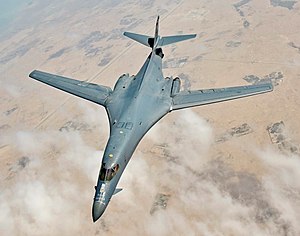
Back قاذفة قنابل استراتيجية Arabic Strateji bombardmançı təyyarə Azerbaijani Стратэгічны бамбавік BE-X-OLD Bombarder estratègic Catalan Strategický bombardér Czech Стратеги авиацийĕ CV Strategischer Bomber German Bombardero estratégico Spanish بمبافکن راهبردی Persian Strateginen pommikone Finnish

A strategic bomber is a medium- to long-range penetration bomber aircraft designed to drop large amounts of air-to-ground weaponry onto a distant target for the purposes of debilitating the enemy's capacity to wage war. Unlike tactical bombers, penetrators, fighter-bombers, and attack aircraft, which are used in air interdiction operations to attack enemy combatants and military equipment, strategic bombers are designed to fly into enemy territory to destroy strategic targets (e.g., infrastructure, logistics, military installations, factories, etc.). In addition to strategic bombing, strategic bombers can be used for tactical missions. There are currently only three countries that operate strategic bombers: the United States, Russia[1] and China.
The modern strategic bomber role appeared after strategic bombing was widely employed, and atomic bombs were first used during World War II. Nuclear strike missions (i.e., delivering nuclear-armed missiles or bombs) can potentially be carried out by most modern fighter-bombers and strike fighters, even at intercontinental range, with the use of aerial refueling, so any nation possessing this combination of equipment and techniques theoretically has such capability. Primary delivery aircraft for a modern strategic bombing mission need not always necessarily be a heavy bomber type, and any modern aircraft capable of nuclear strikes at long range is equally able to carry out tactical missions with conventional weapons. An example is France's Mirage IV, a small strategic bomber replaced in service by the ASMP-equipped Mirage 2000N fighter-bomber and Rafale multirole fighter.
- ^ Paul, T. V.; Wirtz, James J.; Fortmann, Michael. Balance of power: theory and practice in the 21st century, Stanford University Press, 2004, p. 332. ISBN 0-8047-5017-3